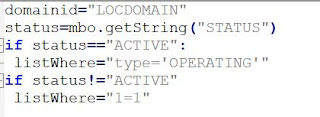Launch Point: Name of
the launch point and description.
Object: Name of
the object.
Attribute: Provide the name of the
attribute on which the script needs to be triggered.
There are two sections visible while creating a new attribute
launch point: Events and Script.
Under Events we have:
- Initialize Access Restriction: This method is used when we need to make fields required or read-only as soon as the record is opened/initialized. For example, you may want to make location field on asset application read-only as soon as the asset record is opened when asset status is OPERATING. This event should be strictly used to make fields required/read-only and no other complex business logic should be written as it may impact the performance of the application. This event is the same as init() method in java class.
- Initialize Value: This event is used when we want to initialize the values of attributes as soon as the record is opened/initialized. An example would be, setting the value of location field on ASSET object to say “ABC” as soon as the asset record is opened. Just like Initialize Access Restriction, use this event only to initialize the values of the fields and no business logic should be introduced here. This event is the same as initValue() method in java class.
- Validate: This event is same as validate() method in java class. This event is used when you have to validate data on the current object or related objects before it is processed. For example, while entering the value of location field on ASSET record you want to validate that the location is OPERATING. If not, you can throw an error.
- Retrieve List: If there is a need to display a dynamic list of values based on certain conditions, retrieve list event can be used. For example, display only OPERATING locations in the location lookup in asset application if the asset status is ACTIVE but if the asset status is not ACTIVE display all types of locations in the lookup. To achieve this, we need to create a table domain in Maximo with object selected as LOCATIONS. Keep the list where clause blank in the table domain. In the automation script we can check for the conditions above and set a dynamic where clause like below:
- Run Action: This event is same as action() method in the java class. It is used to perform actions (setting the values of one field based on another field, adding new mbosets, throwing errors etc.) when the field value is updated.
Under Script we
have same options as I have already discussed in my earlier blog.





No comments:
Post a Comment